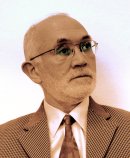|
Plenary
Lecture
Work Directions and New Results in Electronic Travel
Aids for Blind and Visually Impaired People

Professor Virgil Tiponut
Electronic and Telecommunication Faculty
POLITEHNICA University of Timisoara
Romania
E-mail:
virgil.tiponut@etc.upt.ro
Abstract: There are approximately 45 million blind &
visually impaired people world-wide according to the
World Health Report. Vision loss limits the access of
these individuals to the educational opportunities,
social events, public transportation and leads to a
higher rate of unemployment.
Many efforts have been invested in the last years, based
on sensor technology and signal processing, to develop
electronic travel aids (ETA) capable to improve the
mobility of blind users in unknown or dynamically
changing environment. In spite of these efforts, the
already proposed ETAs do not meet the requirements of
the blind community and the traditional tools (white
cane and guiding dogs) are still the only used by
visually impaired to navigate in their working and
living environment.
In this paper, research efforts to improve the main two
components of an ETA tool: the Obstacles Detection
System (ODS) and the Man-machine Interface (MMI) are
presented. Now, for the first time, the ODS under
development is bioinspired from the visual system of
insects, particularly from the Lobula Giant Motion
Detector (LGMD) found in locusts. LGMD is a large neuron
found in optical lobule of the locust, which mainly
responds at the approaching objects. Starting from the
mathematical model of the LGMD, known in the literature,
it has been developed an ODS that can be used by
visually impaired to navigate autonomously with
obstacles avoidance. The already obtained results are
very promising, but some improvements are also possible.
We are developing now preprocessing algorithms for the
visual information applied to the input of the LGMD
neuron, in order to improve the response of the ODS. In
the proposed solution, the position of the detected
obstacles is correlated with the attitude parameters of
the subject's head. In this way, the visually impaired
person detects obstacles in a similar way as a subject
with normal sight is looking for obstacles in front of
him.
The man-machine interface developed in the present
research exploits the remarkable abilities of the human
hearing system in identifying sound source positions in
3D space. The proposed solution relies on the Acoustic
Virtual Reality (AVR) concept, which can be considered
as a substitute for the lost sight of blind and visually
impaired individuals. According to the AVR concept, the
presence of obstacles in the surrounding environment and
the path to the target will be signalized to the subject
by burst of sounds, whose virtual source position
suggests the position of the real obstacles and the
direction of movement, respectively. The practical
implementation of this method encounters some
difficulties due to the Head Related Transfer Functions
(HRTF) which should be known for each individual and for
a limited number of points in the 3D space. These
functions can be determined using a quite complex
procedure, which requires many experimental
measurements. The proposed solution in our research
avoids these difficulties by generating the HRTF's
coefficients using an Artificial Neural Network (ANN).
The ANN has been trained using a public data base,
available for the whole scientific community and which
contains HRTF's coefficients for a limited number of
individuals and a limited number of points in 3D space
for each individual.
The ODS and the MMI presented in the above have been
implemented on a specific hardware build around an
ARM-based microcontroller system. The obtained results
and some conclusions are also presented.
Brief Biography of the Speaker:
Prof. Virgil TIPONUT received the M.Sc. in 1968, in
Electrical Engineering/Computer Science, and the Ph.D.
degree in Electronic Engineering and Telecommunications,
in 1981, both at the POLITEHNICA University of Timisoara,
Romania. Since graduation he is with POLITEHNICA
University of Timisoara and curently he is a professor
at Electronic and Telecommunication Faculty, responsable
for teaching in embedded systems, smart transducers and
neural networks.
His research interests include bioinspired systems, with
application in mobile and rehabilitation robotics and
some closed related areas: smart transducers, neural
networks and fuzzy logic, biomedical engineering,
embedded systems. He has published more than 100 papers
in national and international Journals and Conference
Proceedings, authored 10 books and 10 text books, and
holds 21 patents. He conducted more than 25 research and
development projects, grants and contracts in the field
of embedded systems, robotics and smart transducers.
Prof. Tiponut has been involved in setting up national
and international conferences as a reviewer and/or
member of organizing committee or board of sections. He
was a visiting professor at universities from USA,
Germany, Ireland and Schotland.
He is a member of the IEEE Society (CAS, EMB, RA), WSEAS
Society, member of the Society of Electronic Engineers
from Romania and corresponding member of the Academy of
Technical Science from Romania.
|
